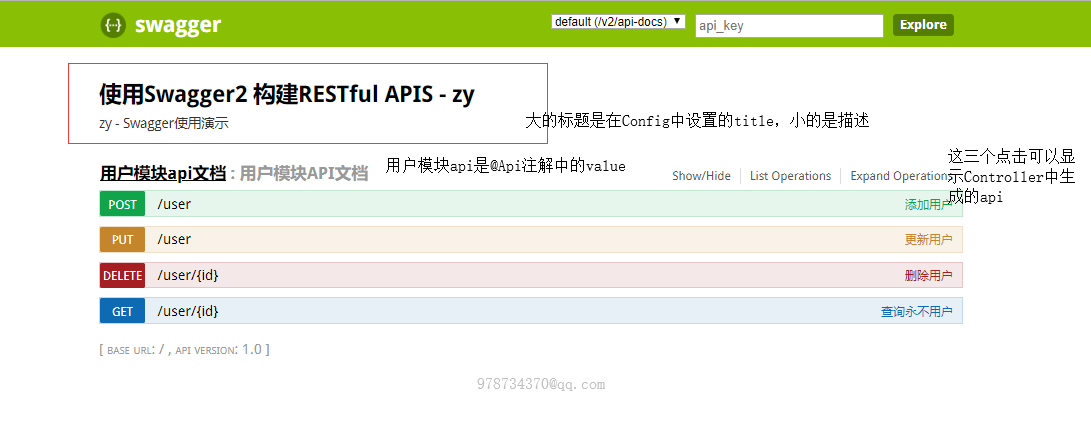Swagger作用:
自动生成javaAPI,避免开发过程中接口文档更新不及时。
Swagger 一.导入依赖:
导入依赖
<!--swagger包-->
<dependency>
<groupId>io.springfox</groupId>
<artifactId>springfox-swagger2</artifactId>
<version>2.2.2</version>
</dependency>
<dependency>
<groupId>io.springfox</groupId>
<artifactId>springfox-swagger-ui</artifactId>
<version>2.2.2</version>
</dependency>
<!--swagger包结束-->
|
Swagger 二.Swagger首页的配置:
创建一个SwaggerConfig类,通过@Configuration托管给spring,然后通过@EnableSwagger2 注解开启Swagger,Config类大部分都是固定的,没什么改变的需要:
代码:
package com.zy100.config;
import org.springframework.context.annotation.Bean;
import org.springframework.context.annotation.Configuration;
import springfox.documentation.builders.ApiInfoBuilder;
import springfox.documentation.builders.PathSelectors;
import springfox.documentation.builders.RequestHandlerSelectors;
import springfox.documentation.service.ApiInfo;
import springfox.documentation.spi.DocumentationType;
import springfox.documentation.spring.web.plugins.Docket;
import springfox.documentation.swagger2.annotations.EnableSwagger2;
/**
* @author 赵振宇
* @date 2019/10/29 0029
* @time 14:51
* @desc Swagger配置类,该类里面的应该是固定的,主要用来设置文档的主题信息,比如文档的大标题,副标题,公司名
* 等
*/
@Configuration//托管spring
@EnableSwagger2//开启swagger功能
public class SwaggerConfig {
/**
* 创建API应用
* apiInfo() 增加API相关信息
* 通过select()函数返回一个ApiSelectorBuilder实例,用来控制哪些接口暴露给Swagger来展现,
* 本例采用指定扫描的包路径来定义指定要建立API的目录。
*
* @return
*/
@Bean
public Docket createRestApi(){
//版本类型是swagger2
return new Docket(DocumentationType.SWAGGER_2)
//通过调用自定义方法apiInfo,获得文档的主要信息
.apiInfo(apiInfo())
.select()
.apis(RequestHandlerSelectors.basePackage("com.zy100.controller"))//扫描该包下面的API注解
.paths(PathSelectors.any())
.build();
}
/**
* 创建该API的基本信息(这些基本信息会展现在文档页面中)
* 访问地址:http://项目实际地址/swagger-ui.html
* @return
*/
private ApiInfo apiInfo() {
return new ApiInfoBuilder()
.title("使用Swagger2 构建RESTful APIS - zy") //接口管理文档首页显示
.description("zy - Swagger使用演示")//API的描述
.termsOfServiceUrl("www.footmark.top")//网站url等
.version("1.0")
.build();
}
}
|
Swagger 三.Swagger的Controller示例
在需要生成接口文档的Controller中加上@API注解,类中需要生成接口的方法上加上@ApiOperation注解:
代码:
package com.zy100.controller;
import io.swagger.annotations.Api;
import io.swagger.annotations.ApiImplicitParam;
import io.swagger.annotations.ApiImplicitParams;
import io.swagger.annotations.ApiOperation;
import org.springframework.web.bind.annotation.*;
import java.util.Date;
import java.util.HashMap;
import java.util.Map;
/**
* @author 赵振宇
* @date 2019/10/29 0029
* @time 15:00
* @desc 配合swagger创建一个Controller,演示方便不再创建service层
*/
@RestController
@Api("用户模块API文档")//注解api说明该类需要生成api文档
public class UserController {
/**
* 该类中
* @param map 类似于一个user对象
* key就是对象的属性
* value就是对象的属性值
* ------------------------
* 属性 id name birthday
* @return
*
*/
//正常业务整添加是对象,前台传JSON对象,在此使用map代替
@PostMapping("/user")//如果使用swagger自动生成接口文档,一定要加上请求类型,不然会导致swagger把所有请求都会生成一下
@ApiOperation("添加用户")
@ApiImplicitParams({
@ApiImplicitParam(name = "map",//参数名字
value = "这是一个添加的对象",//参数的描述
required = true,//是否必须传参数,true是
paramType = "body")//参数类型 body代表json
})
public Map add(@RequestBody Map map){
return map;
}
//根据id删除数据。
@DeleteMapping("/user/{id}")
@ApiOperation("删除用户")//API中说明的该类的作用
@ApiImplicitParams({
@ApiImplicitParam(name = "id",//参数名字
value = "用户id",//参数的描述
required = true,//是否必须传参数,true是
paramType = "path",//参数类型 path代表路径参数
dataType = "int")//参数类型 int
})
public String deltete(@PathVariable int id){
return "{code:200,msg:删除"+id+"成功}";
}
//根据传入的对象信息进行更新
@PutMapping("/user")
@ApiOperation("更新用户")//API中说明的该类的作用
@ApiImplicitParams({
@ApiImplicitParam(name = "map",//参数名字
value = "更新的用户",//参数的描述
required = true,//是否必须传参数,true是
paramType = "body",//参数类型 body
dataType = "map")//参数类型 int
})
public Map update(@RequestBody Map map){
return map;
}
@GetMapping("/user/{id}")
@ApiOperation("查询永不用户")//API中说明的该类的作用
@ApiImplicitParams({
@ApiImplicitParam(name = "id",//参数名字
value = "查询的用户id",//参数的描述
required = true,//是否必须传参数,true是
paramType = "path",//参数类型 body
dataType = "int")//参数类型 int
})
public Map getOne(@PathVariable int id){
Map<String,Object> map = new HashMap<>();
map.put("id",id);
map.put("name","张三");
map.put("birthday",new Date());
return map;
}
}
|
Swagger 四.测试
运行启动类主方法,访问:http://localhost:8080/swagger-ui.html
可以看到效果

